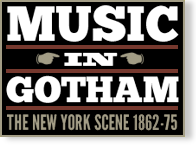New York Conservatory Soiree: 2nd
Event Information
Venue(s):
Irving Hall
Performance Forces:
Instrumental, Vocal
Record Information
Status:
Published
Last Updated:
17 January 2017
Performance Date(s) and Time(s)
16 Nov 1867, 8:00 PMProgram Details
The program also included unidentified vocal duets by Donizetti and Campana, performed by Misses Hedges, Howard, and Remsen.
Performers and/or Works Performed
Citations
“The New-York Conservatory of Music gave its second classical soirée at Irving Hall on Saturday evening to a large and very brilliant audience. The portions of the programme which introduced pupils of the Conservatory to notice were particularly interesting, and the duets from Donizetti and Campana, by Miss Sarah Hedges, Miss Sophie Howard, Miss Lizzie Remsen, as well as Ferreri’s Mazurka air by Miss Burdett were very charmingly given. Such pupils would be a credit to any Academy of Music. A leading feature of Saturday’s concert, also, was the debut of the brothers Listeman in New-York. They are violinists of spirit and most graceful performers. Beethoven's superb quartette in F was the opening piece, and employed, besides the Listemans [sic], Bernhard and Henry Mollenhauer. The four movements of this work call for muscle quite as much as mind in the rightful interpreter, and rarely has Beethoven been so justly expressed as by these performers. In Paganini’s ‘Adagio and Rondo,’ Mr. Bernhard Listeman—who appears to be the most marked of the brothers—was heard at work as deeply poetical as anything ever offered to a violinist of feeling. The whole concert was a complete success, and was in every particular creditable to the flourishing and worthy institution which got it up, Mr. Lepal's good taste was predominant throughout.”
“The soiree of the New-York Conservatory of Music, on Saturday night, drew a large audience, in spite of the counter-attraction of the Philharmonic Concert, Irving Hall being uncomfortably crowded. The programme embraced Beethoven’s Quartette in F for two violins, viola and violoncello, by G. F. and Bernard Listerman [sic] and Bernard and Henry Mollenhauer, the violin Adagio and Rondo of Paganini’s, by Bernard Listerman; the Fantasie for the violoncello, by Mr. Henry Mollenhauer; Beethoven’s Quartette in E flat (Op. 16), for piano, violin, viola and violoncello, by Mr. F. Kirpal, the Listermans [sic], and Henry Mollenhauer; two vocal performances [illeg.] and some creditable singing by young lady pupils of the Conservatory.”

